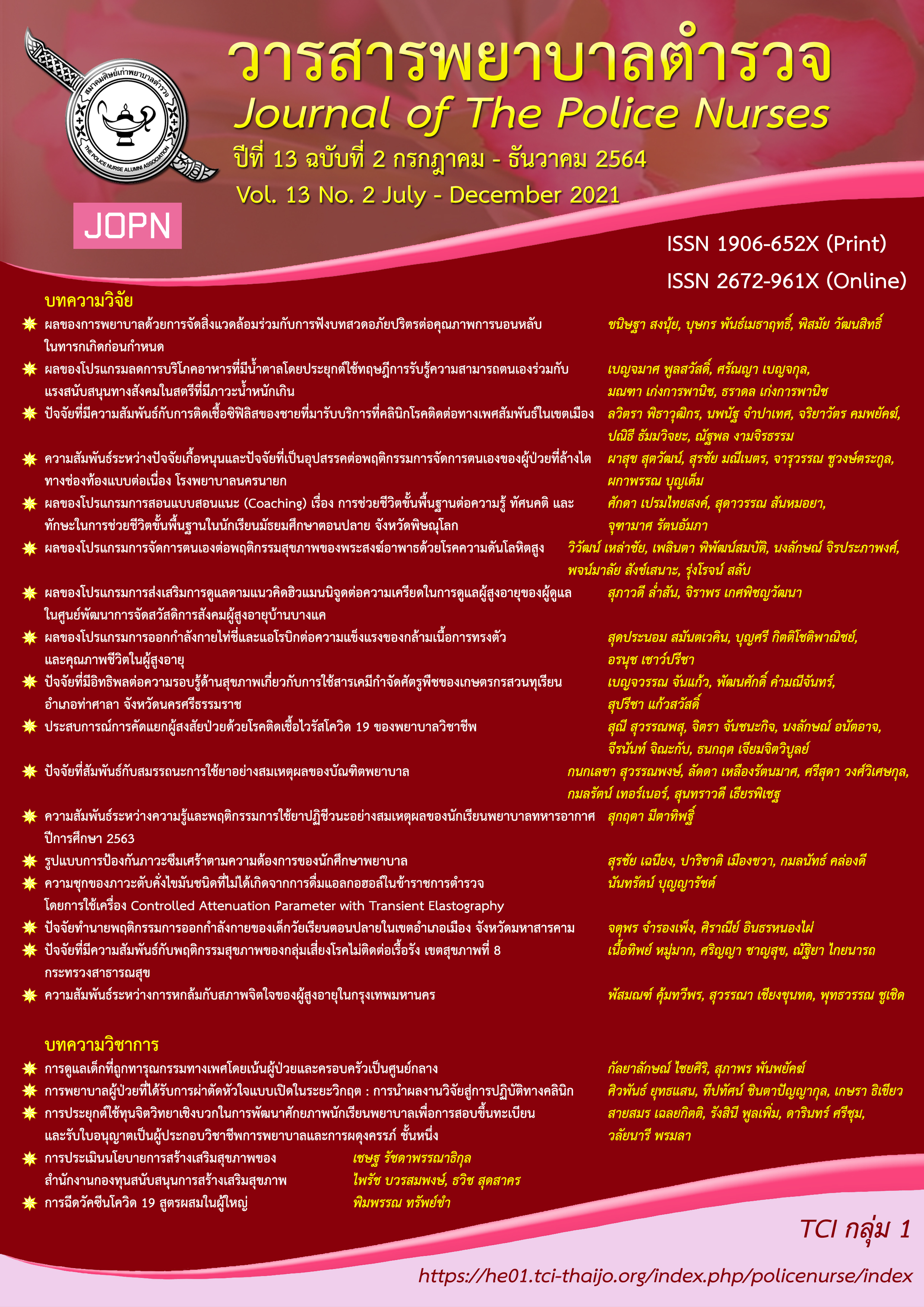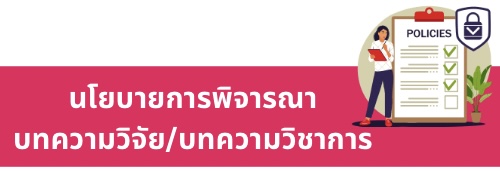ปัจจัยทำนายพฤติกรรมการออกกำลังกายของเด็กวัยเรียนตอนปลาย ในเขตอำเภอเมือง จังหวัดมหาสารคาม
คำสำคัญ:
ปัจจัยทำนาย, พฤติกรรมการออกกำลังกาย, เด็กวัยเรียนตอนปลายบทคัดย่อ
การวิจัยนี้มีวัตถุประสงค์เพื่อศึกษาปัจจัยทำนายพฤติกรรมการออกกำลังกายของเด็กวัยเรียนตอนปลาย ตัวอย่างคือนักเรียนอายุ 10-12 ปี จำนวน 190 ราย ได้มาจากการสุ่มอย่างมีระบบ เก็บข้อมูลโดยใช้แบบสอบถามพฤติกรรมการออกกำลังกายในอดีต แบบสอบถามการรับรู้อุปสรรคในการออกกำลังกาย แบบสอบถามการรับรู้ประโยชน์ในการออกกำลังกาย แบบสอบถามการรับรู้ความสามารถของตนเองในการออกกำลังกาย แบบสอบถามความรู้สึกนึกคิดที่สัมพันธ์กับพฤติกรรมการออกกำลังกาย แบบสอบถามอิทธิพลของครอบครัวที่มีต่อการออกกำลังกาย แบบสอบถามอิทธิพลของครูที่มีต่อการออกกำลังกาย แบบสอบถามอิทธิพลของเพื่อนที่มีต่อการออกกำลังกาย แบบสอบถามการรับรู้อิทธิพลของสิ่งแวดล้อมที่มีต่อการออกกำลังกาย และแบบสอบถามพฤติกรรมการออกกำลังกาย ค่าดัชนีความตรงเชิงเนื้อหาเท่ากับ 1 ทดสอบความเชื่อมั่นโดยใช้ค่าสัมประสิทธิ์แอลฟาของครอนบาคเท่ากับ .76, .97, .93, .97, .83, .93, .85, .95, .91 และ .92 ตามลำดับ วิเคราะห์ข้อมูลด้วยสถิติบรรยาย และการวิเคราะห์ถดถอยเชิงเส้นพหุคูณ
ผลการวิจัยพบว่าปัจจัยที่สามารถทำนายพฤติกรรมการออกกำลังกายของเด็กวัยเรียนตอนปลาย คือ พฤติกรรม
การออกกำลังกายในอดีตและอิทธิพลของครอบครัวที่มีต่อการออกกำลังกาย โดยพฤติกรรมการออกกำลังกายในอดีตมีอิทธิพลสูงสุด (Beta = .690) รองลงมาคือ อิทธิพลของครอบครัวที่มีต่อการออกกำลังกาย (Beta = .148) และปัจจัยทั้งหมดสามารถร่วมกันทำนายความแปรปรวนของพฤติกรรมการออกกำลังกายของเด็กวัยเรียนตอนปลายได้ร้อยละ 56.7 อย่างมีนัยสำคัญทางสถิติที่ระดับ .05 (F (2, 187) = 122.406, p = .000, R = .753, R2= .567, R2Adjusted =.562)
Downloads
เอกสารอ้างอิง
Amornsriwatanakul, A., Nakornkhet, K., Katewongsa, P., Choosakul, C., Kaewmanee, T., Konharn, K., . . . Purakom, A. (2016). Result from Thailand’s 2016 report card on physical activity for children and youth. Journal of Physical Activity and Health, 13(2), S291-S298.
Cohen, J. (1998). Statistical power analysis for the behavioral sciences. New York, NY: Lawerence Enlbaum Associates Publishers.
Cozett, C., Bassett, S. H., & Leach, L. (2016). Factors influencing participation in Physical activity among 11-13 year-old school children in the Western Cape, South Africa. African Journal for Physical Activity and Health Sciences, 22(4:2), 1100-1107.
Danyuthasilpe, C. (2018). Pender’s health promotion model and its applications in nursing practice. Songklanagarind Journal of Nursing, 38(2), 132-141.
Department of Health and Human Services. (2018). Chapter 3: Active children and adolescents. physical activity guidelines for Americans 2nd edition. Washington, DC. Retrieved from https://health.gov/sites/default/files/2019-09/Physical_Activity_Guidelines_2nd_edition.pdf#page=46
Hashem, M., & Mohammad, G. A. (2014). Factors predicting the physical activity behavior of female adolescents: A test of the health promotion model. Journal of Prevention Medicine & Public Health, 47, 64-71.
Hockenberry. M. J., Wilson, D., & Wong, D. L. (2013). Wong’s essential of pediatric nursing (9th ed.). St. Louis: Elseveir Mosby.
Hu, D., Zhou, S., Crowley-McHattan, Z.J. & Liu, Z. (2021). Factors that influence participation in physical activity in school-aged children and adolescents: A systematic review from the social ecological model perspective. International Journal of Environmental Research and Public Health, 18(3147), 1-22.
Joyrod, S., & Songthap, A. (2019). Family role is fundamental in overweight prevention among school children. The Southern College Network Journal of Nursing and Public Health, 6(2), 270-278.
Julvanichpong, T. (2015). Predictive factors of exercise behaviors of junior high school student in Chonburi province. World Academy of Science, Engineering and Technology International Journal of Psychological and Behavioral Sciences, 9(7), 2633-2638.
Kaewkungwal, J., & Singhasivanon, P. (2011). Sample size in clinical research. In P. Pitisuttithum, & C. Pichaensoonthon (Eds.), Textbook of clinical research (pp. 107-144). Bangkok: Amarin Printing and Publishing Public Company Limited.
Konthongtom, T., Nookong, A., & Sangperm, P. (2018). Effects of weight control program on eating and physical activity behaviors among school-aged children with overweight. Journal of Nursing Science Chulalongkorn University, 30(2), 28-40.
Liangruenrom, N., Craike, M., Biddle, S. J. H., Suttikasem, K., & Pedisic, Z. (2019). Correlated of physical activity and sedentary behaviour in the Thai population: A systematic review. BMC Public Health, 19, 414.
Lu, C., Stolk, R. P., Sauer, P. J. J., Sijtsma, A., Wiersma, R., Huang, G., & Corpeleijin, E. (2017). Factor of physical activity among Chinese children and adolescents: A systematic review. International Journal of Behavioral Nutrition and Physical Activity, 14(36), 1-10.
Maneedang, P. (2017). The role of community health nurse in obesity prevention of school children. Journal of Nursing Health Care, 35(4), 16-24.
McGaughey, T., Vlaar, J., Naylor, P. J., Hanning, R. M., Mare, L. L., & Masse, L. C. (2020). Individual and environmental factors associated with participation in physical activity as adolescents transition to secondary school: A qualitative inquiry. International Journal of Environmental Research and Public Health, 17(7646), 1-16.
Pender. N. J., Murdaugh, C. L., & Parsons. M. A. (2006). Health promotion in nursing practice (5th ed.). New Jersey, NJ: Upper Saddle River.
Piaget, J. (1973). The theory of stages in cognitive development. New York, NY: McGraw Hill.
Sanasuttipun, W., & Nookong, A. (2015). Predictive factors for teenagers’ exercise and activity behaviour. Thai Journal of Nursing Council, 30(2), 46-58.
Tongwat, P., & Kitreerawutiwong, N. (2019). Factors predicting physical activity behaviors among grade 4-6 students in Nongkula sub-district, Bang Rakam district, Phitsanulok province. Nursing Journal of the Ministry of Public Health, 29(2), 24-36.
The Royal College Pediatricians of Thailand. (2014). Clinical practice guideline of preventing and caring obesity in children. Retrieved from http://www.thaipediatrics.org/Media/media-20161208151655.pdf
Thongsong, L. (2020). Promoting health literacy for obesity prevention among school students in urban area: Nursing role and evidence-based practice. Kuakarun Journal of Nursing, 27(2), 186-198.
Tuntiakarat, S., Thongbai, W., & Takviriyanun, N. (2015). The effectiveness of obesity prevention program on eating and physical activity behaviors among overweight school-aged children. Journal of Boromarajonani College of Nursing, Bangkok, 31(3), 47-61.
Wang, Y., Yan, AF., Shi, X., Wang, H., Wang, Z., Gittelsohn, J., & Xu, F. (2017). Child and parental perspectives: Implications for childhood obesity prevention in China. Asia Pacific Journal of Clinical Nutrition, 26(5), 888-898.
World Health Organization. (2020). Noncommunicable diseases: Childhood overweight and obesity. Retrieved from https://www.who.int/news-room/q-a-detail/noncommunicable-diseases-childhood-overweight-and-obesity
ดาวน์โหลด
เผยแพร่แล้ว
รูปแบบการอ้างอิง
ฉบับ
ประเภทบทความ
สัญญาอนุญาต
ผลงานที่ได้ตีพิมพ์แล้วจะเป็นลิขสิทธิ์ของวารสารพยาบาลตำรวจ















